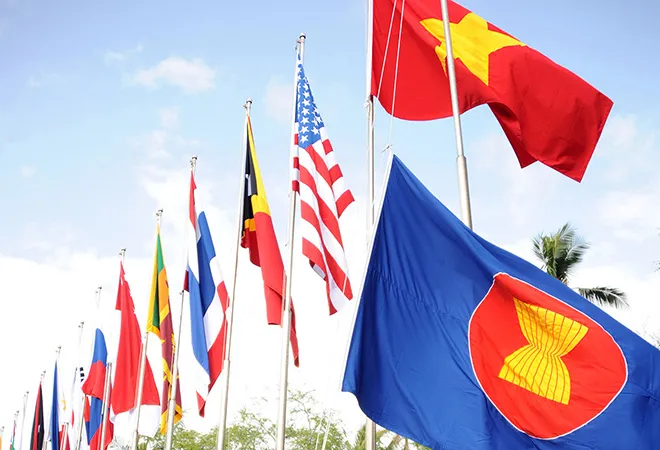 This is the 148th in the series–The China Chronicles.
This is the 148th in the series–The China Chronicles.
Southeast Asia is increasingly becoming a theatre of great power competition between the United States (US) and China because of its location in the broader Indo-Pacific region. Some scholars are of the
opinion that “Southeast Asia looms large as a testing ground for China’s development as a great power and as a gateway for its global expansion in the future.”
On the one hand, China is still handing out economic benefits as a part of its Belt and Road Initiative (BRI) and working with Southeast Asian countries in concluding a Code of Conduct (COC) to help calm the situation in the South China Sea. On the other hand, it is still employing assertive actions in the disputed waters of the South China Sea, with the most recent case being the
accusation by the Philippines that a Chinese Coast Guard was firing water cannons at a Filipino vessel heading for the Second Thomas Shoal, which was carrying food, water, fuel, and other supplies for Filipino military personnel stationed at the shoal.
China is still handing out economic benefits as a part of its Belt and Road Initiative (BRI) and working with Southeast Asian countries in concluding a Code of Conduct (COC) to help calm the situation in the South China Sea.
The US is trying to rebuild its ties with its allies in the region like the Philippines to regain its influence as a response to China’s growing footprints in this region. The recent polls conducted by think tanks like the Lowy Institute and the ISEAS Yusof-Ishak Institute in Singapore
shows that, “China’s rising influence has come largely at the expense of the United States, which is seeing its own influence rapidly ebb in one of the most vital arenas of competition between Beijing and Washington.” This great power competition has put Southeast Asian countries in a tough spot. While the collective response is that these countries do not want to be in a position where they would need to choose sides, each individual country’s response is not the same across the board and varies depending on their national interests, threat perceptions, economic opportunities, geographic proximity, and other factors. This piece will bring out some recent cases, which clearly highlight that the US-China competition is only intensifying in this region, the responses of Southeast Asian countries, and what are the concerns of the ASEAN as a regional bloc.
The great power competition is only intensifying
Though great power competition has existed in this region for quite some time, it is now becoming a matter of great concern as this has led to rapid militarisation of the region. For a long time, the US media has
reported the possibility of China building a military base in Cambodia. But now satellite images from Maxar Technologies
show the dramatic transformation the Cambodian naval base, i.e., the Ream naval base near Sihanoukville on the Gulf of Thailand, is undergoing. There have been
reports that this base can become “China’s second foreign outpost after the opening of a base in the East African nation of Djibouti in 2017.” The satellite imagery, which was released in June 2023, shows the construction of several new buildings, roads, and a pier that is much larger than the size of the base’s original jetty. A Chatham House Report
outlines that the former Cambodian government had given China a land area of 157 hectares for the construction of air defence structures, general command facilities, and a naval radar installation in close proximity to the base. The Cambodian media is also said to have
reported about future plans like building new storage facilities, a hospital, drydocks, and slipways at Ream. The Cambodian government, on the other hand, has repeatedly
stressed that the country’s Constitution does not permit the building of military bases by any foreign country and that is just one of the many infrastructure development projects that China is investing in in Cambodia. China has also invested in the development of the Siem Reap-Angkor International Airport and it has been
reported that 86 percent of the work has been completed and that the plan was to launch aeroplane operations on a pilot basis in June this year and official operations in October 2023.
Under the EDCA, the US has secured access to a total of nine Philippine military bases, including four additional ones that were identified in April 2023.
The US, on the other hand, is strengthening its security partnership with its treaty ally in the region, the Philippines. In February 2023, the Philippines and the US
revived their Enhanced Defense Cooperation Agreement (ECDA). Under the EDCA, the US has
secured access to a total of nine Philippine military bases, including four additional ones that were identified in April 2023. These bases are in close proximity to Taiwan and also the South China Sea. The US has also been vocal in calling out China in case of skirmishes between China and other claimant countries like the Philippines and Vietnam in the South China Sea.
Responses from the region
The responses of the Southeast Asian countries have been varied. While countries like Vietnam and Indonesia are concerned with Chinese belligerence, they are also drawing benefits from both the US and China. When it comes to Indonesia, there is still appetite and demand for attracting Chinese investments for domestic infrastructure development. During Indonesian President Jokowi’s recent visit to China in July 2023, he
held discussions with Chinese President Xi on “a number of priority agendas in the field of investment or various strategic projects of Indonesia and China, along with the fields of trade and health, as well as regional and global issues”. Additionally, he had also
met with Chinese businessmen and entrepreneurs to discuss prospects of Chinese investments in Indonesia. After the ASEAN Foreign Minister’s Meeting last month, Indonesian Foreign Minister, Retno Marsudi, had
stated, “China must be a reliable partner for ASEAN in nurturing an open and inclusive regional architecture. Only then can we achieve win-win cooperation for the sake of peace, stability, and shared prosperity in the Indo-Pacific.” She further
added that China’s support would be needed for the implementation of the ASEAN Outlook on the Indo-Pacific and the ASEAN Indo-Pacific Forum slated to be hosted in September 2023.
If the US has to restore its lost influence in this region, the need is to introduce policy initiatives that would genuinely benefit the region and not just appear as a mechanism to contain the rise of China.
Even if the US is trying hard to regain its lost influence in the region, it will be an uphill task, as China is ASEAN's largest trading partner, and vice versa. Their trade
reaches US$975 billion. China is also the fourth-largest source of foreign direct investment in ASEAN. Memories are still fresh of the US withdrawing from important trade pacts like the Trans-Pacific Partnership (TPP). Though the Indo-Pacific Economic Framework (IPEF) has been launched by the Biden administration to take care of this anomaly, there is little clarity on what kind of market access the Asian nations will get and how much it will benefit the ASEAN countries. If the US has to restore its lost influence in this region, the need is to introduce policy initiatives that would genuinely benefit the region and not just appear as a mechanism to contain the rise of China.
ASEAN’s apprehensions
The process of the conclusion of the COC, as many would say, has been very tedious and slow, but at the ASEAN Foreign Ministers’ Meeting held in Jakarta last month, ASEAN and the People's Republic of China
have agreed on guidelines to accelerate negotiations for the COC in the South China Sea. The aim of these guidelines is to speed up the process of negotiations. These guidelines were adopted during the meeting between ASEAN Foreign Ministers and the Director of the Foreign Affairs Committee of the Central Committee of the Chinese Communist Party, Wang Yi. Though the details of these guidelines are yet to be made public, this is basically the completion of a successful reading of the second draft of the COC. But there are apprehensions that these developments can result in the further slowing of the process of the conclusion of the COC, which, according to the ASEAN member countries, is probably the only feasible way to resolve this conflict in the future.
What needs to be noted is that both the Ream base and the bases allocated to the US under the EDCA are in near proximity to the disputed waters of the South China Sea. This has raised concerns in the minds of the other Southeast Asian nations of whether these developments are signals of a potential conflict in the South China Sea in the near future. If a situation of conflict emerges, besides impacting regional security, how can maritime law be enforced? Especially given that the US is not a signatory to the UNCLOS and China has always defied international law and has interpreted it to suit its own actions and needs. This is currently a matter of concern for the ASEAN. Sometimes, the ASEAN not taking a firm stand on issues like the great power competition is perceived as the bloc being a fractured one, but the fact remains that choosing a middle path in situations like these helps preserve regional tranquillity and reap benefits.
Premesha Saha is a Fellow with the Strategic Studies Programme at the Observer Research Foundation.
The views expressed above belong to the author(s). ORF research and analyses now available on Telegram! Click here to access our curated content — blogs, longforms and interviews.



 This is the 148th in the series–
This is the 148th in the series– PREV
PREV


